Buddhist Pilgrimage in India:

Impression of Buddha feet, Bodh Gaya
Sometime during the sixth century BC, a solitary, wandering ascetic sat to meditate beneath a shady tree at Bodh Gaya, resolving not to rise until he had attained the ultimate knowledge of spiritual enlightenment. Thus began Buddhism, one of the world's great religions and pilgrimage traditions.
Historians, religious scholars, and various Buddhist sects debate the actual year of the Buddha's birth; it may have been as early as 644 BC or as late as 540 BC. It is, however, relatively certain that he was born Prince Gautama Siddhartha, the son of Suddodhana, king of the Shakya tribe. His birthplace was the forest grove of Lumbini in the hilly regions of what is today northeastern India and Nepal. Miraculous events surrounded his birth. Sages prophesied that he would become either a powerful king or, renouncing his royal life, an enlightened being and religious leader. King Suddhodhana, wanting the former and fearing the later, sought to insulate his son from religious and philosophical concerns by surrounding him with a life of ease and plenty. Enclosed within palace walls, the prince grew to manhood and fatherhood never having seen old age, sickness, poverty or death.
Yet this blindness to the full range of human experience was not to last. One day the prince ventured beyond the castle walls and, witnessing the inevitable sufferings of human existence, recognized the shallowness of his pampered life. Metaphysical questions filled his mind and with them the conviction that he must seek and know the great truth of life. Thus, at the age of twenty-nine, he let go the constraints of family and worldly responsibility to tread the path of self-discovery.
Following the ancient traditions of Hinduism, Siddhartha sought out spiritual teachers, or gurus. Inquiring of their knowledge, he diligently practiced various yogas and meditations. Seven years passed, the last three in extreme asceticism, yet still he had not achieved his goal of enlightenment. Finally recognizing that such practices had served him well but were no longer appropriate, Siddhartha journeyed toward the ancient sacred forests of Uruvela (modern Gaya in Bihar, in north India) with the intention of finally and completely realizing the infinite. Guided by visionary dreams and following in the footsteps of Krakucchanda, Kanakamuni, and Kasyapa, the Buddhas of three previous ages, Siddhartha sat beneath the Bodhi Tree. Touching the earth, thereby calling it to witness the countless lifetimes of virtue that had led him to this place of enlightenment, he entered into a state of deep meditation. Three days and nights passed and his intention was realized. Siddhartha became the Buddha, meaning the ‘Enlightened One’.
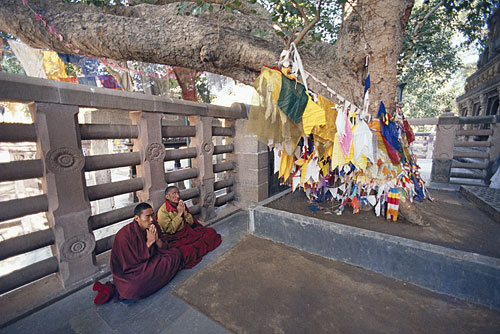
Buddhist Monks at Bodhi Tree (The site of Buddha's enlightenment)
The Buddha spent the next seven weeks in meditation near the Bodhi Tree. Then, at the request of the god Indra, he began to speak of the great truth he had realized. His first sermon was given at Isipatana (modern Sarnath near Banaras). This first discourse, often called "Setting in Motion of the Wheel of Truth" presented the Four Noble Truths and the Noble Eightfold Path for which Buddhism is so famous.
The Four Noble Truths assert that human beings suffer because of the clinging nature of the mind. There is a way out of this suffering, however, and that is through the meditative practices of the Noble Eightfold Path. Through these practices an individual gains insight into how his or her suffering is caused by identification with the mind's processes. Letting go of such identification, one discovers and increasingly resides in a pre-existing state of inner peace.
The Buddha spent the remainder of his life traveling around northeastern India teaching and establishing monastic communities for both men and women. He died at the age of eighty in the village of Kusinara (modern Kushinager, Uttar Pradesh state, India), and his death is known as the parinirvana, the ‘going beyond nirvana’. His body was cremated with great ceremony and the cremation relics were placed in an earthern jar. Soon thereafter the relics were divided into eight portions and these, along with the jar that held them and the embers of the cremation fire, were then distributed among the rulers of eight territories in which the Buddha had traveled and taught. Legends state that ten stupas (Buddhist reliquary shrines) were constructed to house these sacred objects.
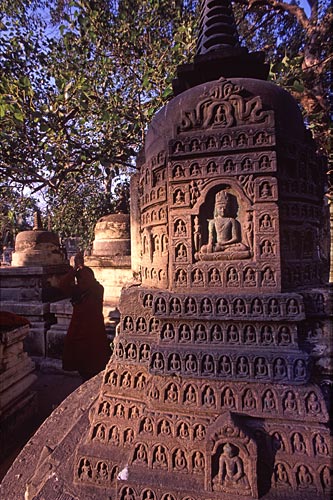
Small Stupa, Bodh Gaya
The origins of the practice of pilgrimage in Buddhism are obscure. Some scholars believe that Buddhist pilgrimage was initially imitative of the practice among Hindus but later became an integral part of the Buddhist tradition, assuming its own distinct features. Buddhists themselves are fond of quoting certain passages from the Mahaparinibbana Sutta in which the Buddha tells his chief disciple, Ananda, that there are four places "...that a devout person should visit and look upon with reverence." These four places are Lumbini, where he was born; Bodh Gaya, where he attained realization; Saranath, where he gave his first teachings; and Kushinager, where he passed away.
While these places are actual geographical locations and the scene of certain events in the Buddha's life, we have no real proof that the Buddha spoke of the practice of pilgrimage. Contrary to popular belief, the Buddha never wrote any of his teachings down. What records we have of his words derive solely from the remembrances of his disciples. Three months after the Paranirvana, five hundred of his chief disciples met in a cave at Rajagraha and by common consensus agreed upon what were to be considered the main teachings of the Buddha. Considerable disagreement arose among them on the finer points of the Buddha's message as is evident from the fact that by the year 100 BC eighteen separate sects had been formed, each with its own interpretation. The teachings were collected together into what came to be known as the Tripitaka, and they were handed down almost wholly by word of mouth till they were finally committed to writing in Ceylon in the first century BC.
Whatever the authenticity of Buddha's injunctions regarding pilgrimage, the four places mentioned above became known as theCaturmahapratiharya, or ‘The Four Great Wonders’ and monks and pilgrims began visiting them. Other places associated with the Buddha's life soon became pilgrimage sites in the new religion. Primary among them were the four sites of: Rajagraha, where the Buddha tamed a maddened elephant; Sravasti, the site of a momentous event known as the Miracle of the Pairs; Vaisali, where monkeys offered the Buddha a gift of honey; and Samkasya, where the Buddha descended from the heavenly realms after teaching his mother. These eight sites together were known asAstamahapratiharya, or ‘The Eight Great Wonders’.
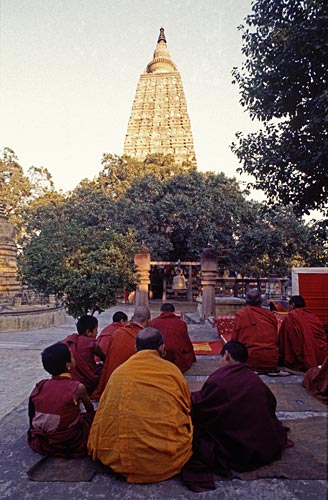
Buddhist monks at Bodh Gaya
Additionally, there were the places where the relics of the Buddha's cremation had been enshrined in stupas (the exact locations of these relic sites are unknown today). Following his conversion to Buddhism in the third century BC, the Emperor Ashoka opened seven of the original stupas and collected their relics. The Asokavadana (accounts of Asoka) relate that the emperor divided these ancient relics into 84,000 portions and vowed to erect a stupa for each portion somewhere in his great empire. While it is highly unlikely that this many stupa reliquaries were actually constructed (the number has symbolic rather than actual meaning), Asoka did establish a number of temples and monasteries that became important sites on the Buddhist pilgrimage circuit.
More important than the actual religious structures Ashoka founded was the impetus he gave to the tradition of Buddhist pilgrimage and, through it, to the spread of Buddhism across the vast Asian landmass. The passion of Ashoka's religious fervor coupled with the force of his imperial patronage initiated and sanctioned both a sacred geography and a pilgrimage practice in Buddhist India. These traditions would be perpetuated by sages such as the 5th- and 7th-century monks Fa-hsien and Hsuan-tsang, who were instrumental in introducing Buddhism to China, and the 8th-century Indian Tantric master, Padmasambhava, who definitively established Buddhism in Tibet.
Besides the funeral relics enshrined by Ashoka in his stupas, other relics of the Buddha such as shavings from his head and clippings from his fingernails began to "appear" or be ''discovered" over the centuries. The authenticity of these relics supposedly deriving from the time of the living Buddha is questionable. Just as false relics were manufactured by unscrupulous Christians during the European medieval ages, so also did the practice occur in the Buddhist world.
Many other places became pilgrimage centers as the religion of Buddhism slowly extended its influence across the vast regions of Asia. In general, there were three primary categories of Buddhist sacred sites that arose in the centuries following Buddha's paranirvana. There is no relative ranking of the sanctity of these three types (or of the individual places within the types) nor did one category arise before the others. One category concerns those places that were considered sacred prior to the arrival of Buddhism and were later incorporated into the fabric of Buddhist sacred geography. Such places could have been the shrines or holy mountains of various shamanistic or proto-religious cults, or the hermitages of sages, yogis, and ascetics. Buddhism from its very inception tended to be a proselytizing religion. Its early proponents and missionaries, intent on gaining converts, naturally sought out those places and communities where spirituality had already manifested. This was especially true in Tibet, where numerous Bon-Po sacred sites were taken over by the Buddhists, and in China, where particular Taoist sacred mountains became the abodes of Buddhist bodhisattvas.
The second category of Buddhist sacred site that arose after the passing away of the Buddha were those places associated with the lives or relics of various sages, saints and teachers in the Buddhist tradition, for example, the well known pilgrimage site of Sanchi in central India. The Buddha never visited this place, yet relics of two of his chief disciples, Sariputra and Maudgalyayana, are enshrined within the great stupa.
A third type of Buddhist pilgrimage sites are those that have their genesis in the manifestation or apparition of various deities. This type of site, seldom encountered in the older Hinayana Buddhist tradition of Sri Lanka and Burma, is quite frequent in the Mahayana tradition as practiced in Tibet, Nepal, China, and Japan.
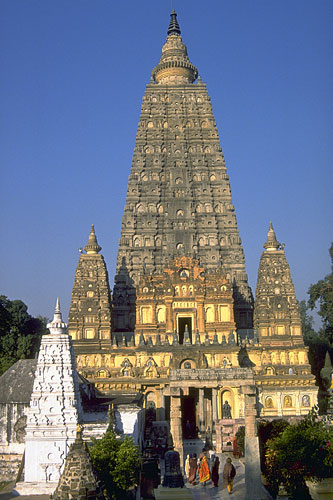
The Mahabodhi Temple, Bodh Gaya, India
Preeminent among all these pilgrimage sites, both old and new, is Bodh Gaya, the place where the Buddha attained enlightenment. As mentioned earlier, this site is traditionally believed to be the place where the Buddhas of the three previous ages had also attained enlightenment. No archaeological remains have been found of any structures dating from the time of the historical Buddha; the earliest temple seems to have been constructed by the Emperor Asoka around 250 BC. This shrine was replaced in the second century AD by the present Mahabodhi temple, which was itself refurbished in AD 450, 1079, and 1157, then partially restored by Sir Alexander Cunningham in the second half of the ninteenth century, and finally fully restored by the Burmese Buddhists in 1882.
The Mahabodhi’s square, truncated tower rises 180 feet (54 meters) above the ground. Its two lower stories house shrines that have served through the ages as places of homage, ritual practices, and meditation. Its upper portion is crowned by a stupa containing relics of the Buddha. Inside the temple is an enormous statue of the Buddha said to be more than seventeen hundred years old. In front of the Buddha image is a Shiva Linga said to have been installed by the great Hindu sage Shankaracharaya. The Hindus believe that the Buddha was one of the incarnations of Lord Vishnu; thus the Mahabodhi temple is a pilgrimage shrine for Hindus as well as Buddhists. Hindus have been visiting Bodh Gaya since at least the Buddha’s own life time, and from the fifteenth century to the early twentieth the site was managed by a lineage of Shiva priests.
Behind the temple are the two most venerated objects in all the Buddhist world, the Bodhi Tree and, beneath it, the Vajrasana, or seat of the Buddha's meditation. The tree standing today, while not the original, is a descendant of the tree growing in Buddha's time. A cutting of that tree was taken to Sri Lanka in the third century BC, where it still flourishes at the sacred site of Anuradhapura. A sapling from that tree was later brought back to Bodh Gaya, where it is still growing today. The Bodhi Tree was harmed, burned, and cut down various times by fanatical Hindus but, according to legend, each time it miraculously regrew. Around the tree and the temple compound are numerous other places rich in association with the Buddha's enlightenment. The environs of Bodh Gaya have attracted sages, yogis, and meditators since the time of Buddha. Such great spiritual figures as Buddhajnana, Padmasambhava, Vimalamitra, Nagarjuna and Atisha have lived and meditated beneath the Bodhi Tree.
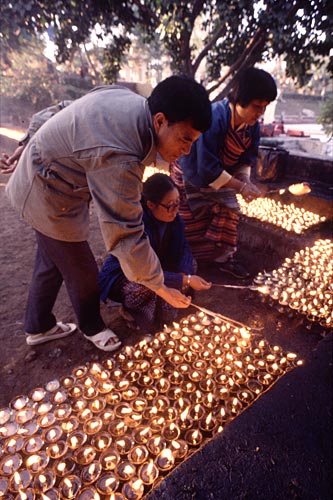
Buddhist Pilgrims lighting candles, Bodh Gaya
No comments:
Post a Comment